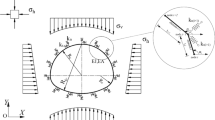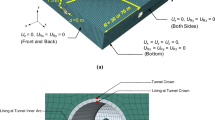Abstract
This study investigated the effects of construction sequence and thrust force from hydraulic jacks on the stress distribution of the tunnel lining by analyzing field data measured at a real Tunnel Boring Machine (TBM) tunnel construction site. A three-dimensional Finite Element (FE) model that incorporated the major design components of a TBM tunnel lining, such as face pressure, shield, grout, and hydraulic jack, as well as the simulation of a step-by-step construction procedure was also proposed. Specifically, the ring joints between linings were modeled using anisotropic solid elements to predict the effects of the jack force on the axial stresses in the lining. The proposed FE model was verified by comparing the numerical results with field data and various analytical and empirical formulas. Through this FE method, extra analyses were conducted with various ground conditions, dimensions of tunnel, and jack forces to investigate the effects of construction stage loads on the behaviors of a TBM tunnel. From analyzing these parametric results and field data, it was concluded that soil elastic modulus has strong influence on axial stresses in lining due to jack forces, and the axial stress of linings converged to roughly 30% of the peak stress.
Similar content being viewed by others
References
Attewell, P. B., and Woodman, J. P. (1982). “Predicting the dynamics of ground settlements and its derivatives by tunneling in soil.” Ground Engineering, Vol. 15, No. 8, pp. 13–22.
Bernat, S., Cambou, B., and Dubois, P. (1998). “Assessing a soft soil tunnelling numerical model using field data.” Geotechnique, Vol. 49, No. 4, pp. 427–452, DOI: 10.1680/geot.1999.49.4.427.
Bobet, A. (2001). “Analytical solutions for shallow tunnels in saturated ground.” Journal of Engineering Mechanics, ASCE, Vol. 127, No. 12, pp. 1258–1266, DOI: 10.1061/(ASCE)0733-9399(2001)127:12 (1258).
Chen, Z., Yu, H., and Yuan, Y. (2012). “Full 3D seismic analysis of a long-distance water conveyance tunnel.” Structure and Infrastructure Engineering, Vol. 10, No. 1, pp. 1–13, DOI: 10.1080/15732479.2012. 707659.
Clough, G. W., Sweeney, B. P., and Finno, R. J. (1983). “Measured soil response to EPB shield tunneling.” Journal of Geotechnical Engineering, Vol. 109, No. 2, pp. 131–149, DOI: 10.1061/(ASCE) 0733-9410(1983)109:2(131).
Ercelebi, S. G., Copur, H., and Ocak, I. (2010). “Surface settlement predictions for Istanbul Metro tunnels excavated by EPB-TBM.” Environmental Earth Science, Vol. 62, No. 2, pp. 357–365, DOI: 10.1007/s12665-010-0530-6.
Kasper, T. and Meschke, G. (2004). “A 3D finite element simulation model for TBM tunneling in soft ground.” International Journal for Numerical and Analytical Methods in Geomechanics, Vol. 28, No. 14, pp. 1441–1460, DOI: 10.1002/nag.395.
Lee, K. M. and Rowe, R. K. (1990). “Finite element modeling of the three dimensional ground deformations due to tunneling in soft cohesive soils: Part I-Method of analysis.” Computers and Geotechnics, Vol. 10, No. 2, pp. 111–138, DOI: 10.1016/0266-352X(90)90001-C.
Luttikholt, A. (2007). Ultimate limit state analysis of a segmented tunnel lining, PhD Thesis, Delft University of Technology, Netherlands.
Mansour, M. A. M. (1996). Three-dimensional numerical modeling of hydroshield tunneling, PhD Thesis, University of Innsbruck, Austria.
Mair, R. J., Gunn, M. J., and O’Reilly, M. P. (1983). “Ground movements around shallow tunnel in soft clay.” Proceedings of 10th International Conference on Soil Mechanics and Foundation Engineering, Stockholm, pp. 323–328.
Migliazza, M., Chiorboli, M., and Giani, G. P. (2009). “Comparison of analytical method, 3D finite element model with experimental subsidence measurements resulting from the extension of the Millan underground.” Computers and Geotechnics, Vol. 36, No. 1, pp. 113–124, DOI: 10.1016/j.compgeo.2008.03.005.
Midas, I. T. (2015). Midas GTS online manual, https://kor.midasuser. com/geotech/
Downloads (2015). Accessed March 2015.
Oteo, C. and Moya, J. F. (1979). “Estimation of the soil parameters of Madrid in relation to the tunnel construction.” Proceedings of 7th Euro Conference on Soil Mechanics and Foundation Engineering. Brington, pp. 239–247.
Peck, R. B. (1969). “Deep excavation and tunneling in soft ground.” Proceedings of 7th International Conference on Soil Mechanics and Foundation Engineering. Mexico, pp. 225–290.
Sagaseta, C. (1987). “Analysis of undrained soil deformation due to ground loss.” Geotechniue, Vol. 37, No. 3, pp. 301–320, DOI: 10.1680/geot.1987.37.3.301.
Schmidt, B. (1969). “Prediction of settlements due to tunneling in soil: three case histories.” Proceedings of 2nd rapid excavation tunneling conference, San Francisco, CA,pp. 801-812.
Verruijt, A. and Booker, J. R. (1996). “Surface settlements due to deformation of a tunnel in an elastic half plane.” Geotechnique, Vol. 46, No. 4, pp. 753–756, DOI: 10.1680/geot.1998.48.5.709.
Yu, H. T., Yuan, Y., Liu, X., Li, Y. W., and Ji, S. W. (2012). “Damages of the Shaohuoping road tunnel near the epcentre.” Structure and Infrastructure Engineering, Vol. 6, No. 4, pp. 435–446, DOI: 10.1080/15732479.2011.647038.
Zhong, D. and Tong, D. (2009). “3D finite element simulation of tunnel boring machine construction processes in deep water conveyance tunnel.” Transactions of Tianjin University, Vol. 15, No. 2, pp. 101–107, DOI: 10.1007/s12209-009-0018-1.
Author information
Authors and Affiliations
Corresponding author
Rights and permissions
About this article
Cite this article
Cho, S.H., Kim, J., Won, J. et al. Effects of jack force and construction steps on the change of lining stresses in a TBM tunnel. KSCE J Civ Eng 21, 1135–1146 (2017). https://doi.org/10.1007/s12205-016-0391-y
Received:
Revised:
Accepted:
Published:
Issue Date:
DOI: https://doi.org/10.1007/s12205-016-0391-y




